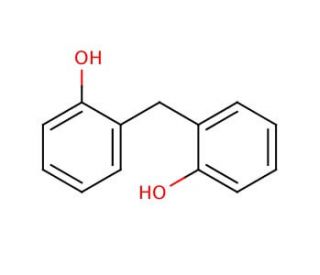

Molecular structure of Bis(2-hydroxyphenyl)methane, CAS Number: 2467-02-9
Bis(2-hydroxyphenyl)methane (CAS 2467-02-9)
Alternate Names:
2,2′-Methylenediphenol
CAS Number:
2467-02-9
Molecular Weight:
200.23
Molecular Formula:
C13H12O2
For Research Use Only. Not Intended for Diagnostic or Therapeutic Use.
* Refer to Certificate of Analysis for lot specific data.
QUICK LINKS
Ordering Information
Description
Technical Information
Safety Information
SDS & Certificate of Analysis
Bis(2-hydroxyphenyl)methane, also known as BPA, is an organic compound with the ability to bind to estrogen receptors. Within the scientific field, Bis(2-hydroxyphenyl)methane finds broad utility. Its employment as a monomer enables the creation of polycarbonates, epoxy resins, and other polymers. Further, it serves as a raw material for synthesizing flame retardants, and adhesives. Bis(2-hydroxyphenyl)methane, facilitates investigations on the impacts of environmental contaminants on health and elucidating the effects of endocrine disruptors on organismal development.Notably, Bis(2-hydroxyphenyl)methane acts as an endocrine disruptor, exerting interference with the normal functioning of hormones.
Bis(2-hydroxyphenyl)methane (CAS 2467-02-9) References
- Vibrational spectra and conformational isomerism of calixarene building blocks: 2-benzylphenol. | Katsyuba, S., et al. 2003. Org Biomol Chem. 1: 714-9. PMID: 12929459
- Synthesis and antimicrobial activities of halogenated bis(hydroxyphenyl)methanes. | Oh, KB., et al. 2009. Bioorg Med Chem Lett. 19: 945-8. PMID: 19097894
- Conformational effects on excitonic interactions in a prototypical H-bonded bichromophore: bis(2-hydroxyphenyl)methane. | Pillsbury, NR., et al. 2009. J Phys Chem A. 113: 5000-12. PMID: 19348452
- Conformational isomerization and collisional cooling dynamics of bis(2-hydroxyphenyl)methane. | Pillsbury, NR., et al. 2009. J Phys Chem A. 113: 5013-21. PMID: 19348453
- Calixarene building block bis(2-hydroxyphenyl)methane (2HDPM) and hydrogen-bonded 2HDPM-H₂O complex in electronic excited state. | Wang, S., et al. 2013. J Mol Model. 19: 1913-8. PMID: 23334370
- The Adsorption of Multinuclear Phenolic Compounds on Activated Carbon | T.R. Dargaville, F.N. Guerzoni, M.G. Looney, D.H. Solomon 1. 1996. Journal of Colloid and Interface Science. 182: 17-25.
- Thermal degradation of halogen-free flame retardant epoxides and polycarbonate in air | Luz Becker 1, D. Lenoir, G. Matuschek, A. Kettrup 2. 2001. Journal of Analytical and Applied Pyrolysis. 60: 55-67.
- Indium(III) chloride catalyzed one step synthesis of some new dibenzo(d,f)(1,3)dioxepines and 12H-dibenzo(d,g)(1,3)dioxocin derivatives | Graziella Tocco 1, Michela Begala, Giovanna Delogu, Carmen Picciau, Gianni Podda. 2004. Tetrahedron Letters. 45: 6909-6913.
- The Anti-Leishmanial Effects of Compounds Derived from the Fungus Geosmithia langdonii on Visceral Leishmaniasis | Nicole Atencio, Kenny Milller, Austin Cheney, B. Andre Benally. 2020. The FASEB Journal. 34: 1-1.
Ordering Information
| Product Name | Catalog # | UNIT | Price | Qty | FAVORITES | |
Bis(2-hydroxyphenyl)methane, 1 g | sc-239354 | 1 g | $107.00 |
